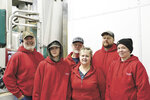

LONG PRAIRIE, Minn. — A lot of options exist when choosing a robotic milking system.
The Clasemanns discovered that finding the right setup and personalizing it takes time and effort, but the change has worked out well for their dairy farm near Long Prairie.
Tony and Debi Clasemann along with their son, Marc, and his girlfriend, Jill Mitchell, operate Clasemann Dairy LLC.
They milk 220 cows with four GEA DairyRobot R9500 milking units. March marked one year since the Clasemanns installed the robots, and they chose the occasion to host an open house showcasing their setup.
Over 30 years ago, Tony and Debi began milking in a stanchion barn. They switched to a parlor and freestall barn in 2004. Several factors led the family to install robots last year.
“Our parlor was at the point where we either needed to stick a bunch of money into it or switch to robots,” Tony said.
Tony also faced knee surgery and was experiencing back problems, so it was time to make a change.
With Tony and Debi looking to retire or scale back from dairy farming, Marc needed to find an option that would allow him and Mitchell to handle most of the work and simultaneously alleviate their struggles to find and maintain hired help. Robots seemed like a solution.
“I was the main pusher for the robots,” Marc said. “With Dad retiring, I needed a way to manage everything with less help.”
With the robots, there is a reduced need for employees, and this has helped the family with the farm’s finances.
“I am able to make the payments for the robots with the money I was spending on payroll,” Tony said.
Before choosing their robotic milking setup, the Clasemanns and Mitchell did online research on different systems. They also reached out to Centre Dairy in Sauk Centre.
“Talking with Jon Stein at Centre Dairy really got the ball rolling,” Tony said. “From there, we asked a lot of questions and explored our options.”
For Marc, who manages crops and oversees farming operations, and Mitchell, who is taking over as herd manager, the feature that drove their robot selection was the option to attach the milking unit manually.
“We have every bit of access to an animal while she is in the robot stall that we had while in the parlor,” Mitchell said. “We can treat, dry off or manually attach the milker right in the robot stall.”
A year into the transition, the Clasemanns and Mitchell agreed that incorporating robots, while a bit nerve-wracking during the process, was worth it.
“The first six weeks, we were questioning why we did this,” Tony said. “The first week, I was getting about four hours of sleep a day. It was stressful. But now, I don’t even touch about 90% of the cows. I do my two hours of chores in the morning, and then, I am done for the day.”
Since the Clasemanns already had a freestall barn, they added 48 feet to the barn to make room for the robots and a sorting pen. They also incorporated a 60-foot addition to the dry cow pen. They continue to bed with sand because they have been happy with it for cow comfort, Tony said. The four robotic units are split, with two on each side of the barn that milk 110 cows per side.
“It takes 1.5-2 hours of walking through the barns in the morning and again at night,” Mitchell said. “That includes checking our treated animals, fresh animals and trouble animals.”
Tony said they were told to expect a 10-pound increase in milk production per cow on average after installing their robotic system. When the setup was first installed, the Clasemanns discovered a need to adjust the herd’s ration to get production back on an even keel. Soon after, they were sitting at close to a 15-pound increase on average.
“We have a couple of cows that have hit 180 pounds a day at their peak but now will stay at 150 pounds for the rest of their lactation,” Tony said. “A lot of our first-time heifers will give 80-100 pounds a day.”
Cows visit the robots on average 2.8 times per day, Tony said. The numerous functions of electronic collars have aided efficiency and improved cow health. Tony said their cull rate was lower than expected at start up.
“The cows will get separated by the robot according to their collar,” Tony said. “So, when I get out there, I can easily find them if I need to breed them or when we have herd health (checks). I don’t have to run around the whole freestall barn trying to find them. This has made all our lives and the veterinarian’s life so much easier.”
With a few adjustments since the initial installation, the Clasemanns have customized their setup to fit their needs, and their cows have flourished.
“It’s been fun seeing the cows adjust,” Tony said. “It’s been a lot of work, but seeing the cows improve has been rewarding.”
Comments
No comments on this item Please log in to comment by clicking here